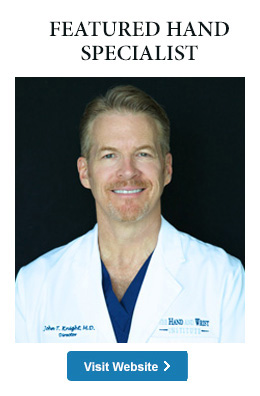Common Procedures
Hand specialists see some of the same problems on a regular basis and there are common procedures used to treat many of them. Some approaches are surgical and others are non-surgical. The decision as to how to treat can be made after consultation with your hand specialist but it might include one of these common procedures.
Carpal TunnelNonsurgical treatment for carpal tunnel syndrome usually involves resting your wrist and taking NSAIDs to help the inflammation go down. Sufferers may also be asked to wear a wrist brace at night in order to avoid bending the joint too much. Most mild cases of carpal tunnel syndrome will resolve this way and sufferers can then learn how to avoid recurrences by avoiding certain activities or performing them differently.
Surgical options are reserved for more severe cases and those that do not respond to conservative treatment. The basic surgery used to treat the condition involves cutting a ligament that puts pressure on the median nerve. This is usually successful in relieving all of the symptoms except numbness in cases where the nerve has already been permanently damaged.
Trigger FingerRest, NSAIDs and a splint are the most common non-surgical treatments for trigger finger. Avoidance of repetitive motion is also important for ensuring that the condition resolves successfully. In some cases steroids are injected into the tendon sheath to help relieve the inflammation caused by the condition.
Surgical treatment involves releasing the tendon that is locking the finger in position. A semi-surgical treatment performed under local anesthesia accomplishes the same goal using a needle. Usually these procedures are only performed after more conservative treatment has failed.
Cubital TunnelCubital tunnel syndrome is usually managed conservatively if possible. Two treatments used in conservative management include wearing an elbow pad to protect the funny bone against impact and wearing a splint at night to prevent over-bending the arm. Avoidance of certain activities that can exacerbate the problem is also key.
Surgical treatment involves relieving pressure on the ulnar nerve. Several surgical treatments are possible which may involve moving the nerve to the front of the arm, covering it protectively with your fat or muscle tissue or trimming the piece of bone that causes compression of the nerve when the elbow is bent.
Tennis ElbowConservative management of tennis elbow through the use of "active rest" usually results in a good outcome. This process begins with resting the arm and avoiding movements that cause pain. NSAIDs or other pain relievers may be taken to reduce swelling and help make you more comfortable. Exercises and physical therapy combined with making changes in the way you move will help the tendon to become stronger and avoid re-injury.
Surgery is a last resort for tennis elbow and involves either releasing the tendon or repairing the damage. Some tears can be surgically mended while others cannot and require the tendon to be cut in order to relieve the pain. Surgery is performed in only about 5 percent of tennis elbow cases.
de Quervain's Stenosing TenosynovitisTreatment for de Quervain's usually involves NSAIDs and rest. Often, a splint is used to immobilize the joint while it heals. Corticosteroid injections can completely resolve the issue if caught early enough and are often used in the nonsurgical treatment of the condition. Physical therapy may be prescribed and the avoidance of repetitive movements is usually indicated to help prevent a recurrence.
Surgical treatment for de Quervain's involves opening the tendon sheath covering the tendons that are causing pain. This allows the tendons to glide freely and do their job without pain. Milder cases are usually treated conservatively while long-term or more severe cases may be treated with surgery.

